Family: Tenthredinidae
Family common name: common sawflies
Subfamily: Tenthredininae
Tribe: Macrophyini
Genus: Macrophya Dahlbom, 1835
Subgenera: Macrophya, Pseudomacrophya
The Tenthredinidae are the most species-rich family and are found throughout the world, in all continents but Antarctica. They are known as the “common sawflies.” They can generally be recognized by a cylindrical body and long, segmented antennaeantenna:
the sensory organ emerging from the front of the head, usually between the compound eyes and above the clypeus; includes the flagellum, scape and pedicel
 . Otherwise, they come in a variety of colors, sizes, and forms (Goulet 1992Goulet 1992:
. Otherwise, they come in a variety of colors, sizes, and forms (Goulet 1992Goulet 1992:
Goulet H. 1992. The genera and subgenera of the sawflies of Canada and Alaska: Hymenoptera. Symphyta. The insects and arachnids of Canada. Part 20. Agriculture Canada Publication.).
Sawflies in the Tenthredininae subfamily are relatively large as compared to others in the family, often with distinct colorful markings. Some are wasp-like with black and yellow stripes (Goulet 1992Goulet 1992:
Goulet H. 1992. The genera and subgenera of the sawflies of Canada and Alaska: Hymenoptera. Symphyta. The insects and arachnids of Canada. Part 20. Agriculture Canada Publication.). Many species’ life histories are not known. Some Tenthredininae species feed uniquely, as adults, on flower pollen and other insects (Smith 1993Smith 1993:
Smith DR. 1993. Systematics, life history, and distribution of sawflies. Pp. 3-32. In: Wagner MR and Raffa KF, eds. Sawfly Life History Adaptations to Woody Plants. University of Minnesota Academic Press. 581 pp.). They can be distinguished from other subfamilies by wing venationvenation:
the network of veins on a wing
(Goulet 1992Goulet 1992:
Goulet H. 1992. The genera and subgenera of the sawflies of Canada and Alaska: Hymenoptera. Symphyta. The insects and arachnids of Canada. Part 20. Agriculture Canada Publication.).
Macrophya is a medium-large black sawfly often with white, yellow, or red markings. The genus is relatively species-rich and common in North America (Gibson 1980bGibson 1980b:
Gibson GAP. 1980b. A revision of the genus Macrophya Dahlbom (Hymenoptera: Symphyta, Tenthredinidae) of North America. Memoirs of the Entomological Society of Canada 114: 1-167.).
There are 231 described extantextant:
in existence; opposite of extinct
species worldwide. Forty-eight species occur in North America (Taeger et al. 2010Taeger et al. 2010:
Taeger A, Blank SM, and Liston AD. 2010. World Catalog of Symphyta (Hymenoptera). Zootaxa 2580: 1-1064.).
Subfamily characters
 vein M and 1m-cu parallel (Goulet 1992Goulet 1992:
vein M and 1m-cu parallel (Goulet 1992Goulet 1992: vein R bent at basebase:
vein R bent at basebase: Sc (Goulet 1992Goulet 1992:
Sc (Goulet 1992Goulet 1992: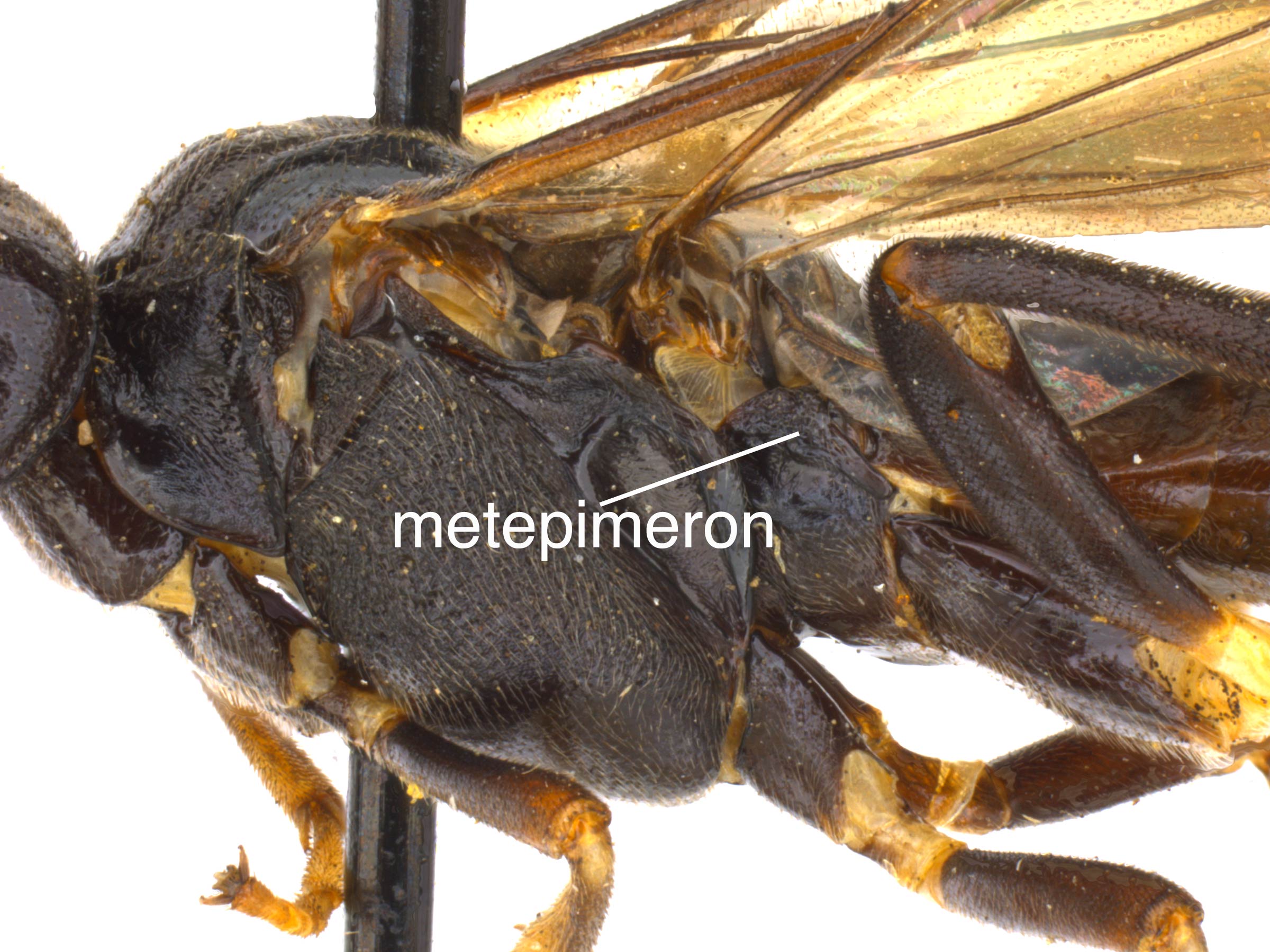 separated from metepisternummetepisternum:
separated from metepisternummetepisternum: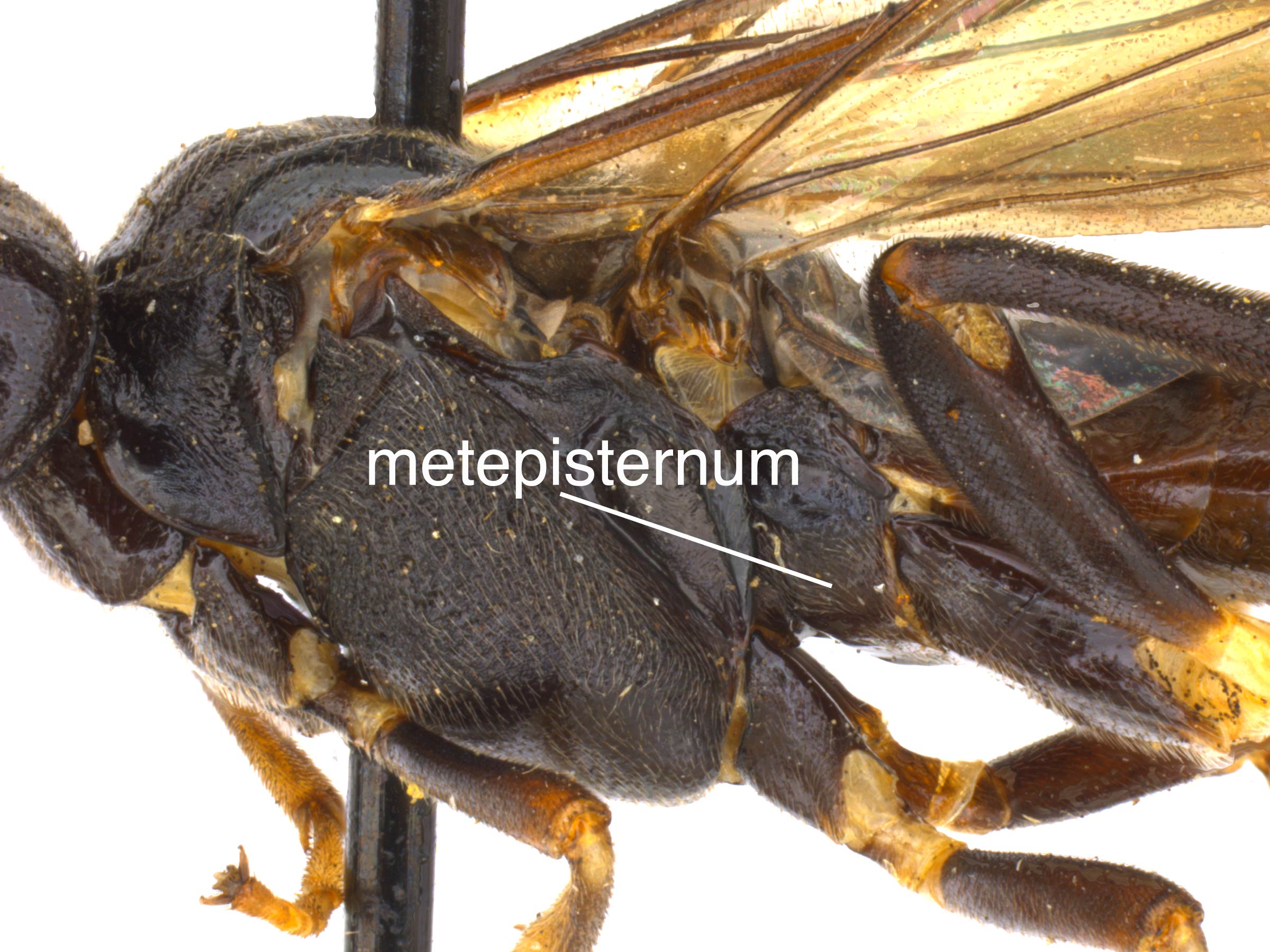 by distinct furrowfurrow:
by distinct furrowfurrow: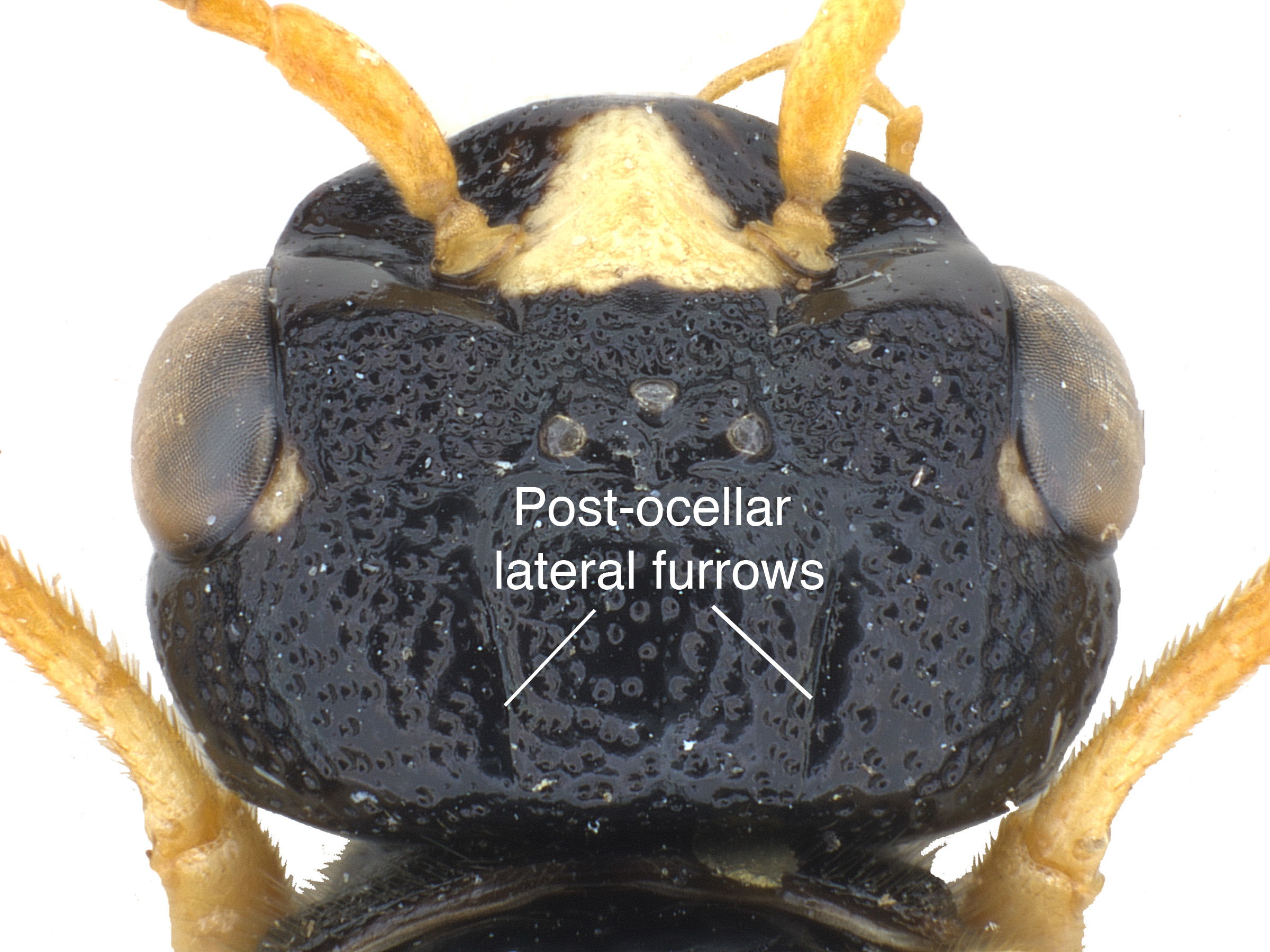 (Goulet 1992Goulet 1992:
(Goulet 1992Goulet 1992:Genus characters
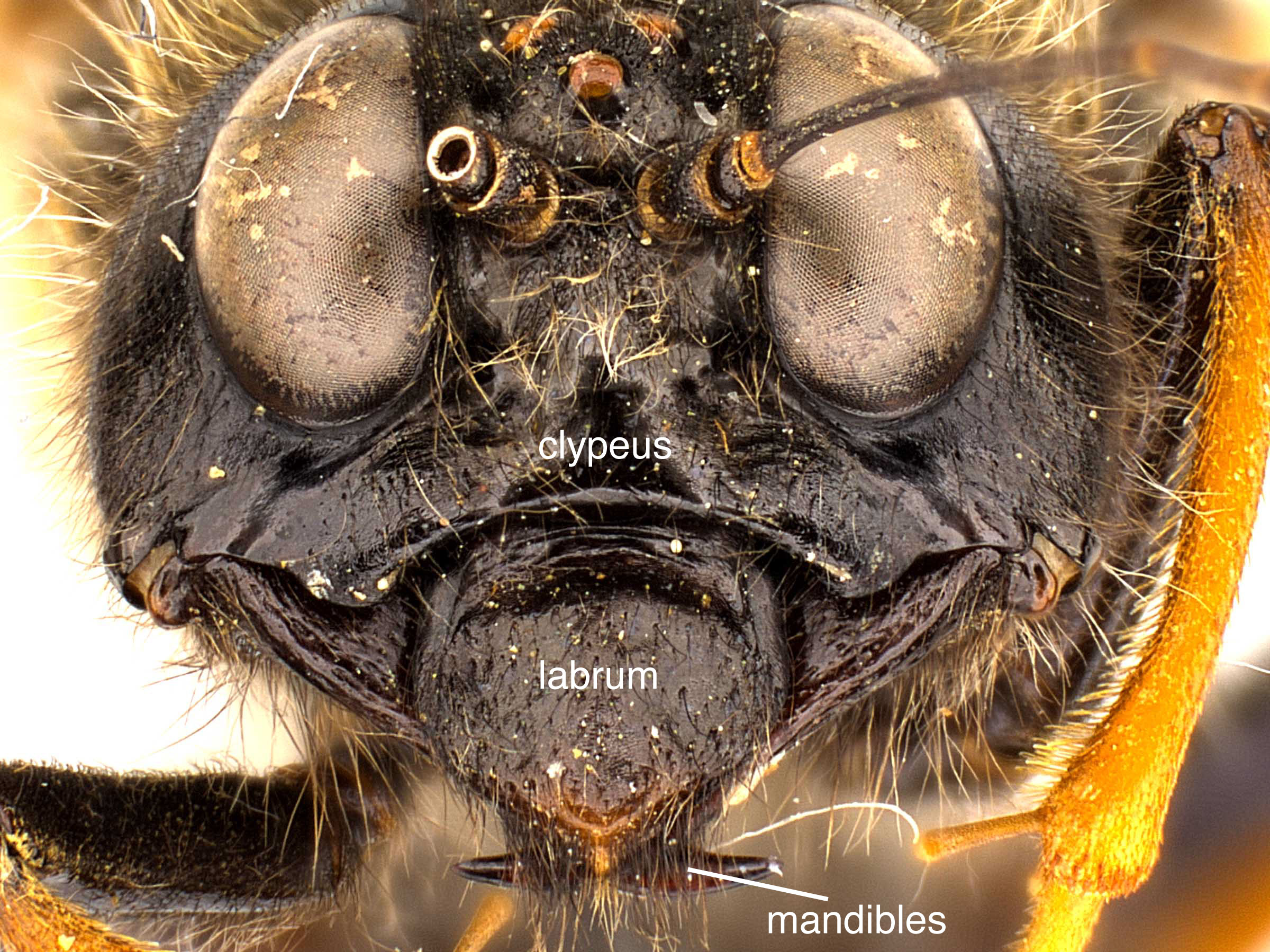 longer than medial length of the clypeusclypeus:
longer than medial length of the clypeusclypeus: (Goulet 1992Goulet 1992:
(Goulet 1992Goulet 1992: 1.5X length of second flagellomereflagellomere:
1.5X length of second flagellomereflagellomere: (Goulet 1992Goulet 1992:
(Goulet 1992Goulet 1992: vein 2A+3A complete, connected to 1A by crossveincrossvein:
vein 2A+3A complete, connected to 1A by crossveincrossvein: anal crossveinanal crossvein:
anal crossveinanal crossvein: vein 2r present (Goulet 1992Goulet 1992:
vein 2r present (Goulet 1992Goulet 1992: vein M intersecting Sc+R basalbasal:
vein M intersecting Sc+R basalbasal: veins 1m-cu and Cu1 120°–150° (Goulet 1992Goulet 1992:
veins 1m-cu and Cu1 120°–150° (Goulet 1992Goulet 1992: anal crossveinanal crossvein:
anal crossveinanal crossvein: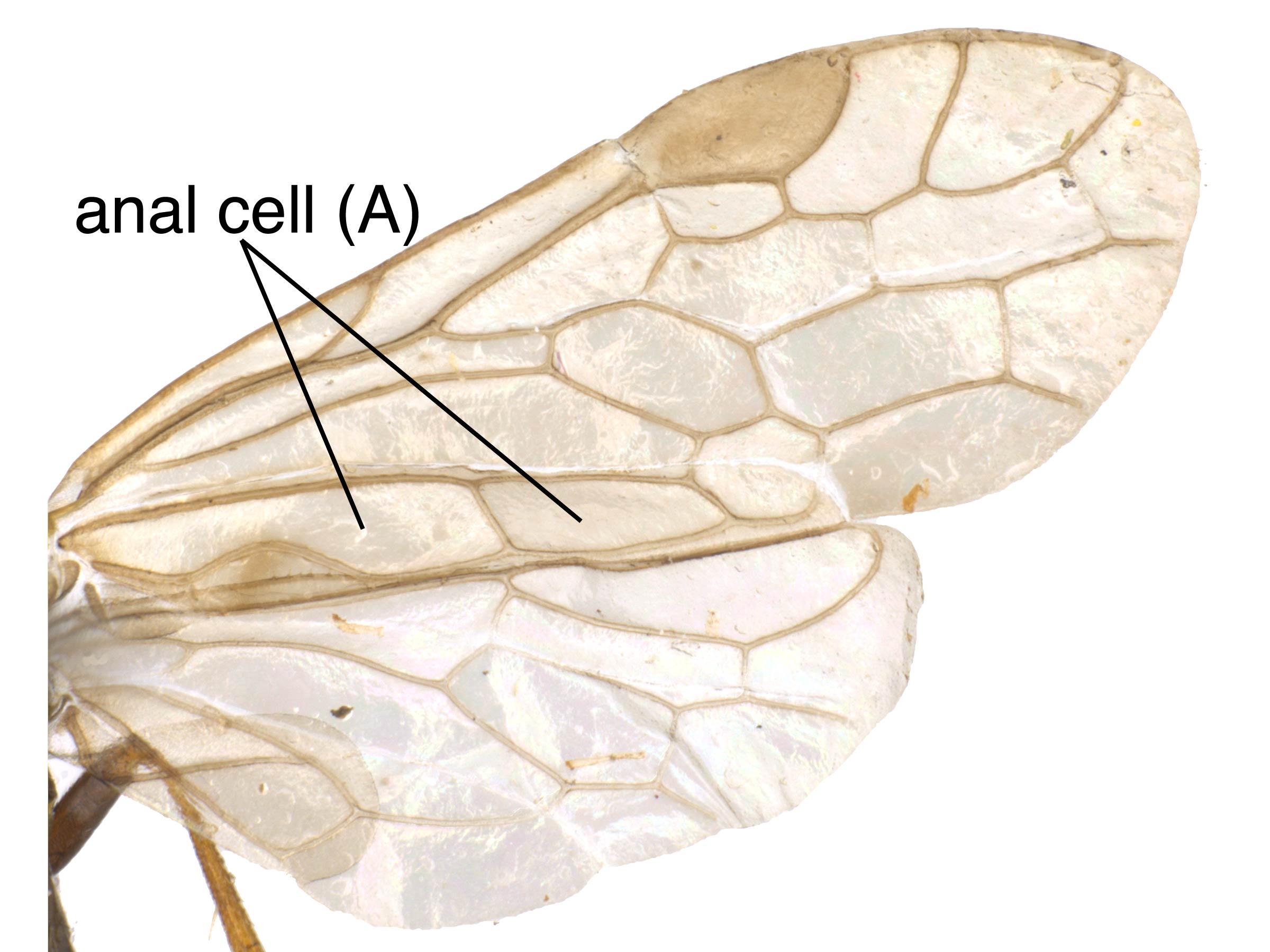 ; or anal veins appearing fused for a short distance (Goulet 1992Goulet 1992:
; or anal veins appearing fused for a short distance (Goulet 1992Goulet 1992: distinctly angled on lower posterior corner (Goulet 1992Goulet 1992:
distinctly angled on lower posterior corner (Goulet 1992Goulet 1992: (Goulet 1992Goulet 1992:
(Goulet 1992Goulet 1992:Macrophya can be confused with similar species in the subfamily Tenthredininae. It can be distinguished from most other genera by the expanded metepimeronmetepimeron:
the dorsal portion of the metapleuron
 , long labrumlabrum:
, long labrumlabrum:
a sclerotized structure on the front of the head between the clypeus and mandibles
 , and the centered anal crossveinanal crossvein:
, and the centered anal crossveinanal crossvein:
a crossvein that goes through the center of the basal anal cell
(Goulet 1992Goulet 1992:
Goulet H. 1992. The genera and subgenera of the sawflies of Canada and Alaska: Hymenoptera. Symphyta. The insects and arachnids of Canada. Part 20. Agriculture Canada Publication.).
none
Macrophya in North America feed on Rudbeckia (coneflower), Carya (hickory), Prunus (cherry, plum), Fraxinus (ash), Ligustrum (privet), Syringa (lilac), Castanea (chestnut), Viburnum, Sambucus (elderberry), Mentha (mint), Geum (avens), Plantago (plantain), Filipendula, Scrophularia (figwort), Solanum (nightshade), Senecio (ragwort), Rubus (blackberry), Geranium, Valerinana (valerian), Potentilla (cinquefoil), Aster, Carex (sedges), and some genera of grasses (Gibson 1980bGibson 1980b:
Gibson GAP. 1980b. A revision of the genus Macrophya Dahlbom (Hymenoptera: Symphyta, Tenthredinidae) of North America. Memoirs of the Entomological Society of Canada 114: 1-167., Smith and Middlekauff 1987Smith and Middlekauff 1987:
Smith DR and Middlekauff WW. 1987. Suborder Symphyta. In: Stehr FW ed. Immature Insects. Kendall/Hunt Publishing Company. Vol. 1: 754 pp., Goulet 1992Goulet 1992:
Goulet H. 1992. The genera and subgenera of the sawflies of Canada and Alaska: Hymenoptera. Symphyta. The insects and arachnids of Canada. Part 20. Agriculture Canada Publication.). Macrophya nigra feeds on Dasistoma macrophylla (mullein foxglove) (Eiseman et al. 2017Eiseman et al. 2017:
Eiseman CS, Smith DR, and Leoschke MJ. 2017. Host, larva, and life history notes for Macrophya nigra (Norton) (Hymenoptera: Tenthredinidae). Proceedings of the Entomological Society of Washington 119(1): 142-145.).
Macrophya larvaelarva:
the immature stage of holometabolous insects
 are external leaf-feeders. At maturity the prepupae fall to the ground and make a cellcell:
are external leaf-feeders. At maturity the prepupae fall to the ground and make a cellcell:
1. a membranous area of the wing between veins, 2. a small cavity or closed space
 in the soil to overwinter (Gibson 1980bGibson 1980b:
in the soil to overwinter (Gibson 1980bGibson 1980b:
Gibson GAP. 1980b. A revision of the genus Macrophya Dahlbom (Hymenoptera: Symphyta, Tenthredinidae) of North America. Memoirs of the Entomological Society of Canada 114: 1-167.). Adults fly in the spring (Smith 1991Smith 1991:
Smith DR. 1991. Flight records for twenty-eight species of Macrophya Dahlbom (Hymenoptera: Tenthredinidae). Proceedings of the Entomological Society of Washington 93 (3): 772-775.).
Macrophya punctumalbum, commonly known as the privet sawfly, was introduced to both eastern and western Canada and is now established in British Columbia, Ontario, Quebec, and New York. The adult oviposits under the epidermis on the upper side of the leaf and the larvaelarva:
the immature stage of holometabolous insects
 feed on the leaf tissue in irregular, round holes. In large quantities, the larvaelarva:
feed on the leaf tissue in irregular, round holes. In large quantities, the larvaelarva:
the immature stage of holometabolous insects
 can entirely defoliatedefoliate:
can entirely defoliatedefoliate:
to elimate a sizeable portion of the foliage of a tree, either by feeding on the leaves or otherwise causing a severe decreae in photosynthetic ability
the host plant (Hoebeke and Johnson 1985Hoebeke and Johnson 1985:
Hoebeke ER and Johnson WT. 1985. A European privet sawfly, Macrophya punctumalbum (L.): North American distribution host plants, seasonal history and descriptions of the immature stages (Hymenoptera: Tenthredinidae). Proceedings of the Entomological Society of Washington 87 (1): 25-33.). The larvalarva:
the immature stage of holometabolous insects
 of M. punctumalbum is separated from other species in the genus by its uniform bright green color (Gibson 1980bGibson 1980b:
of M. punctumalbum is separated from other species in the genus by its uniform bright green color (Gibson 1980bGibson 1980b:
Gibson GAP. 1980b. A revision of the genus Macrophya Dahlbom (Hymenoptera: Symphyta, Tenthredinidae) of North America. Memoirs of the Entomological Society of Canada 114: 1-167.). This species actually feeds on the foliage of its host plant as an adult (Hoebeke and Johnson 1985Hoebeke and Johnson 1985:
Hoebeke ER and Johnson WT. 1985. A European privet sawfly, Macrophya punctumalbum (L.): North American distribution host plants, seasonal history and descriptions of the immature stages (Hymenoptera: Tenthredinidae). Proceedings of the Entomological Society of Washington 87 (1): 25-33.).
World: The genus is present throughout North America, Europe, and Asia (Gibson 1980bGibson 1980b:
Gibson GAP. 1980b. A revision of the genus Macrophya Dahlbom (Hymenoptera: Symphyta, Tenthredinidae) of North America. Memoirs of the Entomological Society of Canada 114: 1-167., Taeger et al. 2010Taeger et al. 2010:
Taeger A, Blank SM, and Liston AD. 2010. World Catalog of Symphyta (Hymenoptera). Zootaxa 2580: 1-1064.).
North America: Macrophya occurs throughout Canada and United States, as far north as the Alaskan panhandle and extending south into Florida and Texas (Gibson 1980bGibson 1980b:
Gibson GAP. 1980b. A revision of the genus Macrophya Dahlbom (Hymenoptera: Symphyta, Tenthredinidae) of North America. Memoirs of the Entomological Society of Canada 114: 1-167.).
Map data from: GBIF.org (29 October 2019) GBIF Occurrence Download Macrophya
Details about data used for maps can be found here.